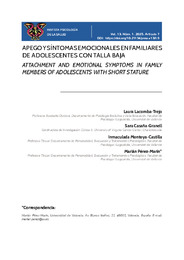Resumen :
El cuidado de un hijo adolescente con una condición médica como la talla baja (TB) se asocia con síntomas emocionales. Factores sociodemográficos o clínicos como el número de hijos, si presentan al-guna condición crónica, o la afectación de la talla del adolescente y factores psicológicos como el apego seguro pueden amortiguar el impacto. El objetivo fue estudiar los factores sociodemográficos, clínicos y psicológicos como el apego, relacionados con los síntomas emocionales de personas cuidadoras fa-miliares de adolescentes con TB. Tras la aprobación del Comité de Ética y la firma del consentimiento informado participaron 157 personas cuidadoras familiares con TB. Evaluamos variables sociodemográ-ficas, ansiedad, depresión y malestar emocional mediante la Escala Hospitalaria de Ansiedad y Depre-sión (HADS) y apego a través del Cuestionario de Apego Adulto (CAA). Se llevaron a cabo estadísticos descriptivos, pruebas t de Student y correlaciones de Pearson. Un gran porcentaje presentó síntomas ansiosos (46,90%), depresivos (17,50%) y malestar emocional (14,40%). El apego seguro, la presencia de menor cantidad de hijos, la ausencia de condiciones crónicas en otros hijos y una menor afectación de la talla del hijo se asociaron con menor sintomatología. Es importante atender a la familia en el pro-ceso de evaluación y tratamiento ante la enfermedad.
Caring for an adolescent with a medical condition such as short stature (SS) is associated with emo-tional symptoms in caregivers. Sociodemographic or clinical factors, such as the number of children, the presence of any chronic condition, or the degree of height impairment in the adolescent, along with psychological factors like secure attachment, may buffer the impact. This study aimed to examine the socio-demographic, clinical and psychological factors, like attachment, associated with the emotional symptoms of caregivers of adolescents with SS. After receiving Ethics Committee approval and obtain-ing informed consent, 157 caregivers of adolescents with SS participated. We assessed sociodemo-graphic variables, anxiety, depression, and emotional distress using the Hospital Anxiety and Depres-sion Scale (HADS) and attachment via the Adult Attachment Questionnaire (CAA). Descriptive statistics, Student’s t-tests, and Pearson correlations were conducted. A substantial proportion presented with anxiety symptoms (46.90%), depressive symptoms (17.50%), and emotional distress (14.40%). Secure attachment, fewer children, the absence of chronic conditions in other children, and less height impair-ment in the adolescent were associated with lower symptomatology. Attending to the family during the evaluation and treatment process is essential when managing the condition
|
 La licencia se describe como: Atribución-NonComercial-NoDerivada 4.0 Internacional.
La licencia se describe como: Atribución-NonComercial-NoDerivada 4.0 Internacional.
.png)
